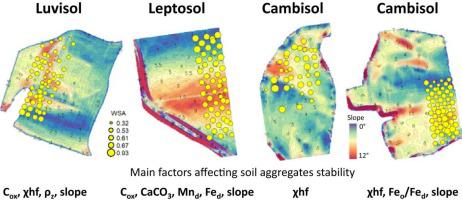Soil and Tillage Research ( IF 6.5 ) Pub Date : 2022-02-24 , DOI: 10.1016/j.still.2022.105348 Lenka Pavlů 1 , Radka Kodešová 1 , Radim Vašát 1 , Miroslav Fér 1 , Aleš Klement 1 , Antonín Nikodem 1 , Aleš Kapička 2

|
The stability of soil structure is crucial for providing most of the essential functions of soil. In our previous research in a region of Chernozem soil, multiple linear regression analysis showed that soil aggregate stability within this morphologically diverse study area could be predicted using the soil organic matter content and one of the terrain attributes. Therefore, this present study aims to determine if a similar procedure can be applied to areas of different soil types, namely a Haplic Luvisol, two Haplic Cambisols, and a Calcaric Leptosol. Basic soil properties such as the organic carbon (Cox) content, Fe content, Mn content, CaCO3 content, pH, magnetic susceptibility, bulk density (ρz), electrical conductivity, and water-stable aggregate (WSA) index were measured, and terrain attributes were derived using a system for automated geoscientific analyses and a digital elevation model.
It was found that it was not possible to propose similar predictive models for all locations. The models included different combinations of the Cox content, CaCO3 content, Fe content, ρz, and various terrain attributes. The Cox content was the main parameter that positively affected the WSA index values in the areas of Luvisol and Leptosol soils. Magnetic susceptibility was the main parameter that positively correlated with the WSA index in the two areas of Cambisols, and in one Cambisol area, the WSA index was also positively correlated with the ratio between amorphous and crystalline Fe forms. Negative impacts were observed for ρz (Luvisol and one Cambisol) and the CaCO3 content (Leptosol). From the terrain attributes, slope was mostly included in the predictive models. The other attributes were the catchment slope and profile curvature. The best model prediction assessed based on the coefficient of determination was found for the Leptosol area (R2 =0.69), followed by the Luvisol are (R2 =0.60) and both Cambisol areas (R2 =0.52, respectively 0.33).
中文翻译:

使用选定的土壤和地形特性估计受水侵蚀影响区域表土聚集体的稳定性
土壤结构的稳定性对于提供土壤的大部分基本功能至关重要。在我们之前对黑钙土地区的研究中,多元线性回归分析表明,可以使用土壤有机质含量和地形属性之一来预测这个形态多样的研究区域内的土壤团聚体稳定性。因此,本研究旨在确定是否可以将类似程序应用于不同土壤类型的区域,即 Haplic Luvisol、两种 Haplic Cambisols 和 Calcaric Leptosol。基本土壤性质,例如有机碳 (C ox ) 含量、Fe 含量、Mn 含量、CaCO 3含量、pH、磁化率、容重 (ρ z)、电导率和水稳性骨料 (WSA) 指数进行了测量,并使用自动地球科学分析系统和数字高程模型推导出地形属性。
发现不可能为所有位置提出类似的预测模型。这些模型包括C ox含量、CaCO 3含量、Fe 含量、ρ z和各种地形属性的不同组合。C ox含量是对 Luvisol 和 Leptosol 土壤区域 WSA 指数值产生积极影响的主要参数。磁化率是与 Cambisols 两个区域的 WSA 指数正相关的主要参数,并且在一个 Cambisol 区域,WSA 指数也与非晶态和晶态 Fe 形式的比率呈正相关。观察到 ρ z(Luvisol 和一种 Cambisol)和 CaCO 3的负面影响含量(Leptosol)。从地形属性来看,坡度主要包含在预测模型中。其他属性是集水坡度和剖面曲率。Leptosol 区域 (R 2 = 0.69)的最佳模型预测是基于确定系数评估的,其次是 Luvisol 区域 (R 2 =0.60) 和 Cambisol 区域 (R 2 = 0.52,分别为 0.33)。



























 京公网安备 11010802027423号
京公网安备 11010802027423号